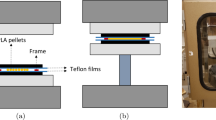Abstract
Poly(ethylene terephthalate) (PET) was blended with 5 wt % of an elastomeric block copolymer. The hydrogenated styrene-butadiene-styrene (SEBS) elastomers were functionalized with 0–4.5 wt % maleic anhydride grafted on the midblock. Notched tensile tests in the temperature range − 40–55 °C differentiated among the blends in terms of their toughness. The least effective elastomer was the unfunctionalized SEBS; all the functionalized SEBS elastomers effectively increased the toughness of PET. Fractographic analysis indicated that PET and the blend with unfunctionalized SEBS fractured through a pre-existing craze. Although adhesion of the unfunctionalized SEBS to the matrix was poor, the elastomer strengthened the craze somewhat, as indicated by an increase in length of the pre-existing craze when final separation occurred. A functionalized SEBS caused the fracture mechanism to change from crazing to ductile yielding. Graft copolymer formed by reaction of PET hydroxyl end groups with the anhydride in situ was thought to act as an emulsifier to decrease particle size and improve adhesion. These factors promoted cavitation, which relieved the triaxiality at the notch root and permitted the matrix to shear yield.
Similar content being viewed by others
References
V. TANRATTANAKUL, W. G. PERKINS, F. L. MASSEY, A. MOET, A. HILTNER and E. BAER, Polymer (in press).
idem, ibid. (in press).
I. WALKER and A. A. COLLYER, in “Rubber toughened engineering plastics”, edited by A. A. Collyer (Chapman & Hall, London, 1994) p. 29.
C. CHENG, A. HILTNER, E. BAER, P. R. SOSKEY and S. G. MYLONAKIS, J. Appl. Polym. Sci. 52 (1994) 177.
idem, J. Mater. Sci. 30 (1995) 587.
D. L. WILFONG, A. HILTNER and E. BAER, ibid. 21 (1986) 2014.
M.-P. LEE, A. HILTNER and E. BAER, Polym. Engng. Sci. 32 (1992) 909.
D. DOMPAS, G. GROENINCKX, M. ISOGAWA, T. HASEGAWA and M. KADOKURA, Polymer 35 (1994) 4750.
E. S. SHIN, A. HILTNER and E. BAER, J. Appl. Polym. Sci. 46 (1992) 213.
J. MURRAY and D. HULL, J. Polym. Sci. A-2 8 (1970) 583.
M. J. DOYLE, J. Mater. Sci. 17 (1982) 204.
W. DÖLL, in “Fractography and failure mechanics of polymers and composites”, edited by A. C. Roulin-Moloney (Elsevier Applied Science, London, 1989) p. 387.
C. CHENG, N. PEDUTO, A. HILTNER, E. BAER, P. R. SOSKEY and S. G. MYLONAKIS, J. Appl. Polym. Sci. 53 (1994) 513.
C. J. CHOU, K. VIJAYAN, D. KIRBY, A. HILTNER and E. BAER, J. Mater. Sci. 23 (1988) 2533.
H.-J. SUE and A. F. YEE, ibid. 24 (1989) 1447.
M. C. M. van der SANDEN and H. E. MEIJER, Polymer 35 (1994) 2774.
K. DIJKSTRA, J. ter LAAK and R. J. GAYMANS, ibid. 35 (1994) 315.
Author information
Authors and Affiliations
Rights and permissions
About this article
Cite this article
Tanrattanakul, V., Perkins, W.G., Massey, F.L. et al. Fracture mechanisms of poly(ethylene terephthalate) and blends with styrene-butadiene-styrene elastomers. Journal of Materials Science 32, 4749–4758 (1997). https://doi.org/10.1023/A:1018678913914
Published:
Issue Date:
DOI: https://doi.org/10.1023/A:1018678913914




